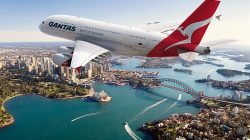I wrote earlier about Alaska Airlines planning to join the oneworld Alliance, as well as an interview with Brett Catlin that suggested there were no major devaluations coming to the Mileage Plan loyalty program as a result. However, “no major devaluations” doesn’t necessarily mean no changes. I just got a survey in my inbox asking me to comment on some competing loyalty programs as well as compare different hypothetical versions of a new Mileage Plan.
(And lest you get too excited, know that some businesses run surveys like this all the time. Even if they have no plans to make a change the data can still tell them which features their customers like best and feel strongly about.)

It started out with a softball: How much more would I pay to fly on a preferred carrier because I liked their loyalty program? Historically that answer has been $20, but I admit I value my convenience much more these days, and status helps.
Then I was asked about programs in detail. The two specific competing programs I was asked to evaluate were Delta’s Sky Miles and United’s MileagePlus. Not surprising. I didn’t think they would ask me much about their new buddy, American Airlines. I gave the responses you would expect if you’ve been reading my writing on this blog for the last few years. MileagePlus has gotten way too complicated. I was a 1K for many years but feel like I don’t recognize the airline anymore. I was never much of a fan of Sky Miles, but it’s a decent program for a well-run airline.
Then I was asked similar questions about two different versions of Mileage Plan. One is the version we know today with MVP, MVP Gold, and MVP Gold 75K status. The other was “Mileage Plan 2.” It’s actually very similar but with some new benefits for those who fly only 5,000 or 10,000 miles a year.
For each version of the program I was asked for my overall opinion on topics like whether I felt the program was rewarding or if I would recommend it to friends. I gave slightly higher marks to the current program.
Tier 1 – 5,000 miles flown per calendar year
- Complimentary drink voucher to use on a future flight
- Complimentary WiFi pass for a future flight
Tier 2 – 10,000 miles flown per calendar year
- All Tier 1 benefits, plus
- Priority boarding
Tier 3 – 20,000 miles flown per calendar year
- All Tier 2 benefits, plus
- Earn 1.5 miles per mile flown
- Complimentary upgrades upon availability
- 2 free checked bags
- Priority check in and boarding
- Preferred seating
- Lounge membership discount
Tier 4 – 40,000 miles flown per calendar year
- All Tier 3 benefits, plus
- Earn 2 miles per mile flown
- Higher upgrade priority
- Express security at select airports
- Waived change fees
- Waived same day confirmed change fees
- Complimentary premium beverage in main cabin
- 4 guest upgrades
- Companion upgrades
Tier 5 – 75,000 miles flown per calendar year
- All Tier 4 benefits, plus
- Highest upgrade priority
- 4 Alaska Lounge day passes
- 50,000 mile one-time bonus
There were also some questions about new redemption options like checked baggage fees, lounge access, and in-flight food and beverage. Yeah, I guess those are fine if other people want them, but I’m not going to use them.
Finally, there were some questions about potential benefits changes. These were presented in the context of a binary choice between two sets of benefits, most of which were the same except for one or two differences. This is a common survey technique that allows the analyst to determine which feature is most important. (You can change one, then keep that change and change another to see if the response is the same.) I’ll share just the options that were being compared:
- Rewards never expire vs. Rewards expire if you don’t earn or redeem at least once every 2 years.
- Can redeem rewards with loyalty currency only vs. Can redeem rewards by combining loyalty currency and money.
- Elite status starting after 5,000 miles flown vs. Elite status starting after 20,000 miles flown.
- 3 possible ways to redeem: flights, hotels, and events vs. 8 possible ways to redeem: flights, hotels, events, in-flight purchases, fees, lounge membership, car rentals, and merchandise.
- No ticket change fees vs. $125 change fee
- Earn 1 mile per mile flown on Alaska Airlines vs. Earn 5% back in “Alaska cash” on all spend with Alaska Airlines.
Overall, I didn’t see anything that worried me too much. The biggest issue would be getting 5% cash back, which is not much different from what United, Delta, and American already do (although heavily disguised).
Would Alaska do this? I don’t think so. Everyone I’ve ever spoken to at the airline has been committed to “a mile flown is a mile earned.” It’s unique, and they need to be unique to stand out in a crowded and competitive landscape.






